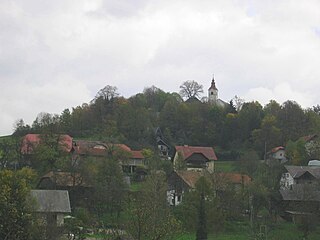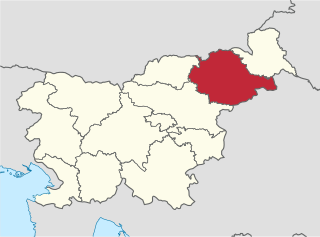| Spodnja Senarska | |
|---|---|
| Coordinates: 46°33′17.99″N15°53′16.44″E / 46.5549972°N 15.8879000°E Coordinates: 46°33′17.99″N15°53′16.44″E / 46.5549972°N 15.8879000°E | |
| Country | |
| Traditional region | Styria |
| Statistical region | Drava |
| Municipality | Sveta Trojica v Slovenskih Goricah |
| Area | |
| • Total | 3.26 km2 (1.26 sq mi) |
| Elevation | 230.7 m (756.9 ft) |
| Population (2002) | |
| • Total | 114 |
| [1] | |
Spodnja Senarska (pronounced [ˈspoːdnja sɛˈnaːɾska] ) is a village in the Municipality of Sveta Trojica v Slovenskih Goricah in northeastern Slovenia. It lies on the edge of the Pesnica Valley. The area was part of the traditional region of Styria and is now included in the Drava Statistical Region. [2]

A village is a clustered human settlement or community, larger than a hamlet but smaller than a town, with a population ranging from a few hundred to a few thousand. Though villages are often located in rural areas, the term urban village is also applied to certain urban neighborhoods. Villages are normally permanent, with fixed dwellings; however, transient villages can occur. Further, the dwellings of a village are fairly close to one another, not scattered broadly over the landscape, as a dispersed settlement.

Slovenia, officially the Republic of Slovenia, is a sovereign state located in southern Central Europe at a crossroads of important European cultural and trade routes. It is bordered by Italy to the west, Austria to the north, Hungary to the northeast, Croatia to the southeast, and the Adriatic Sea to the southwest. It covers 20,273 square kilometers (7,827 sq mi) and has a population of 2.07 million. One of the successor states of the former Yugoslavia, Slovenia is a parliamentary republic and a member of the United Nations, of the European Union, and of NATO. The capital and largest city is Ljubljana.

The Pesnica is a river in Styria, southeastern Austria and Styria, northeastern Slovenia. It is 69 km long, of which 65 km in Slovenia. Its catchment area is about 550 km2, of which 539 km2 in Slovenia. Its source is near Glanz an der Weinstraße, near the Austrian-Slovenian border. It passes Zgornja Kungota, Pesnica, Pernica, the castle at Hrastovec v Slovenskih Goricah, Lenart v Slovenskih Goricah, the monastery of Sveta Trojica v Slovenskih Goricah, Dornava, and Velika Nedelja, and then merges with the Drava near Ormož, on the border with Croatia.
Archaeological evidence points to Roman-era settlement of the area with burial mounds and remains of other contemporary structures. [3]
The archaeological record is the body of physical evidence about the past. It is one of the core concepts in archaeology, the academic discipline concerned with documenting and interpreting the archaeological record. Archaeological theory is used to interpret the archaeological record for a better understanding of human cultures. The archaeological record can consist of the earliest ancient findings as well as contemporary artifacts. Human activity has had a large impact on the archaeological record. Destructive human processes, such as agriculture and land development, may damage or destroy potential archaeological sites. Other threats to the archaeological record include natural phenomena and scavenging. Archaeology can be a destructive science for the finite resources of the archaeological record are lost to excavation. Therefore, archaeologists limit the amount of excavation that they do at each site and keep meticulous records of what is found. The archaeological record is the physical record of human prehistory and history, of why ancient civilizations prospered or failed and why those cultures changed and grew. It is the story of the human world.

In historiography, ancient Rome is Roman civilization from the founding of the city of Rome in the 8th century BC to the collapse of the Western Roman Empire in the 5th century AD, encompassing the Roman Kingdom, Roman Republic and Roman Empire until the fall of the western empire. The civilization began as an Italic settlement in the Italian peninsula, dating from the 8th century BC, that grew into the city of Rome and which subsequently gave its name to the empire over which it ruled and to the widespread civilisation the empire developed. The Roman empire expanded to become one of the largest empires in the ancient world, though still ruled from the city, with an estimated 50 to 90 million inhabitants and covering 5.0 million square kilometres at its height in AD 117.

A tumulus is a mound of earth and stones raised over a grave or graves. Tumuli are also known as barrows, burial mounds or kurgans, and may be found throughout much of the world. A cairn, which is a mound of stones built for various purposes, may also originally have been a tumulus.






